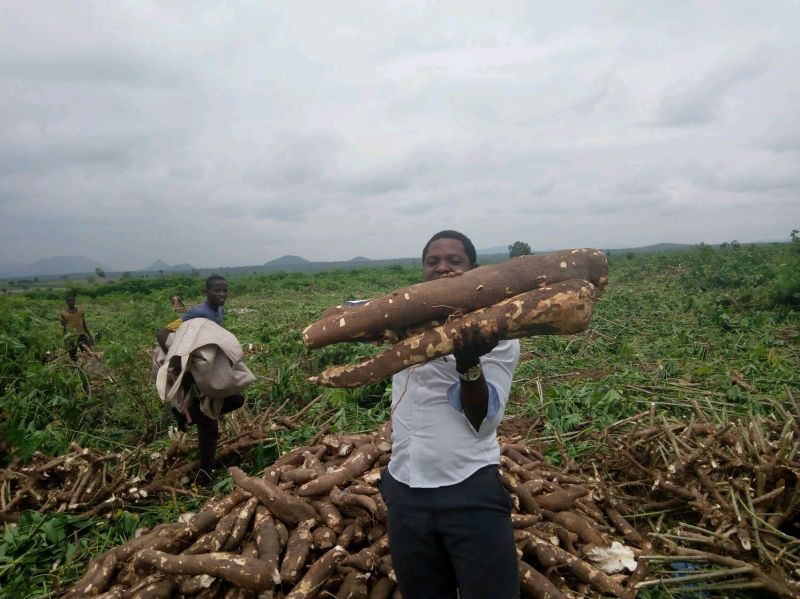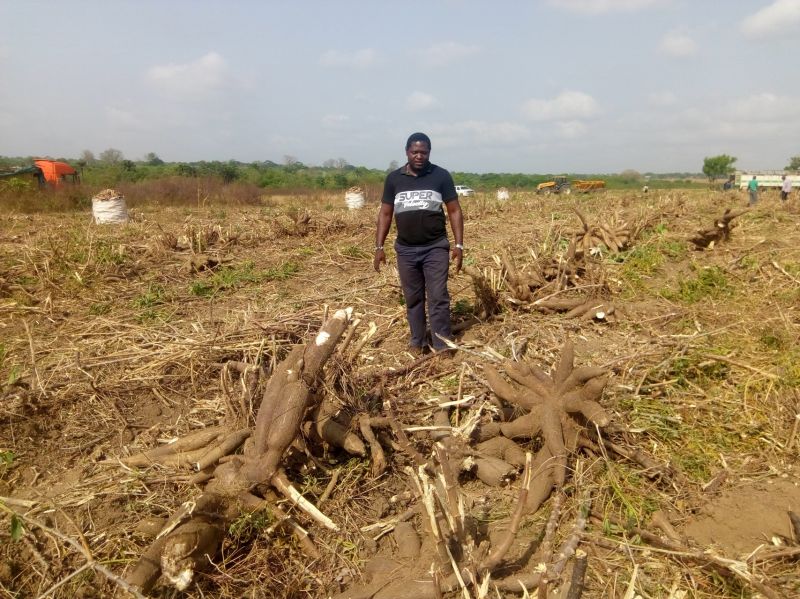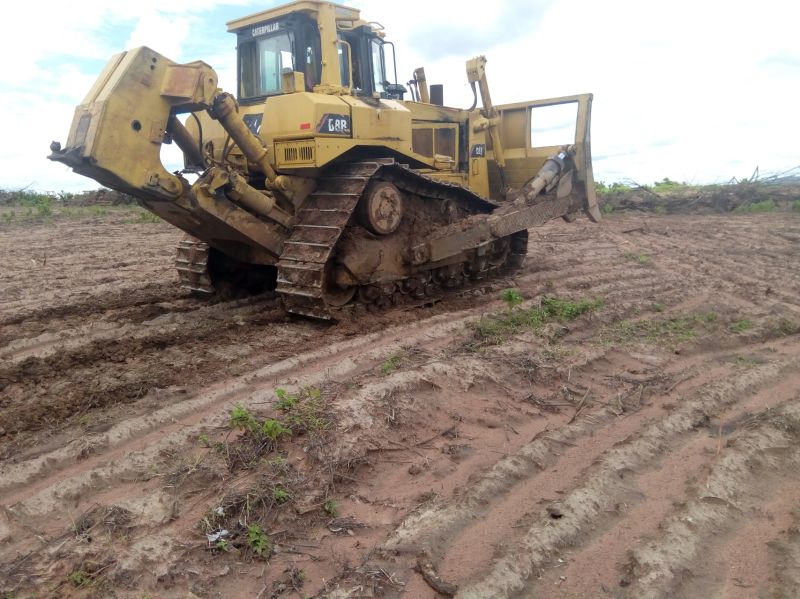Cassava Harvest, Yield per hectare and Storage

This post is also available in:
This post is also available in:
![]() Türkçe (Turkish)
Türkçe (Turkish) ![]() Ελληνικά (Greek)
Ελληνικά (Greek)
When and How to Harvest Cassava
The harvesting of cassava is becoming one of the serious bottlenecks bewildering the cassava production value chain. Harvesting is critical in the cassava production value chain. Cassava needs approximately maximum 9-12 months to mature [1, 2, 3]. This depends on the variety. Early-maturing varieties are harvested 6-7 months after planting, while late-maturing varieties can be harvested after 12 months. Every fully grown cassava tuber may weigh 1 or 2 kilograms (2.2-4.4 lbs), depending on the variety [5, 6,7,8,9]. Once the cassava tubers are lifted from the ground, they cannot be kept for long before they begin to get spoiled. One of the main signs used to determine thr maturity of cassava is that the leaves start turning yellow and dry. At that moment, the cassava crops are likely to be mature enough for the roots to be harvested. Cassava is harvested traditionally by hand lifting the lower part of the stem. This can be done by hand pulling the roots out of the ground and removing the cassava tuber from the base of the stem. There are various harvesting methods for cassava (manual and mechanized harvesting methods). The manual method of harvesting cassava is the most popular in Nigeria.

Harvesting cassava manually
Manual harvesting of cassava involves holding the stem and gently pulling the roots out of the ground. A manual hand lifter can also be used to lift the tubers. Manual harvesting is both labor- and cost-intensive and associated with drudgery and great root damage, especially under arid soil conditions. Manual harvesting requires skill and patience to minimize harmful impact on the tubers. Manual harvesting increases the total cost of production. This is because more farmhands are usually required to harvest to meet industrial and local demands, leading to increased cassava prices on the market. For this kind of harvesting method to be successful, the soil used to grow the cassava plants must be considered. Manual harvesting is much easier on wet loamy soil than on dry soil [1, 2, 3].

Mechanized method of harvesting cassava
The mechanized method of harvesting cassava is less popular than the manual harvesting of cassava. The mechanical harvesting involves using a harvesting implement connected to a tractor to cut and later dig up the roots for the cassava tubers. One popular mechanized implement is the Loval Cassava Harvester (≥90 HP) [1, 2, 3]. This machine helps with minimum losses of cassava tuber and has proven to be quite helpful. However, this harvesting mode can only be done with modifications peculiar to a particular farmer and condition [4, 5, 6]. The mechanical harvester operates with a chain system that uproots the cassava from the soil and then removes the soil from the tubers manually separated from the stem. Mechanizing cassava harvesting is not immune from challenges. Planting methods, land topography and scale of cultivation are key concerns that may affect the mechanized harvesting of cassava [10, 11]. Mechanized method of harvesting reduces the number of workers needed, especially when workers are in short supply and expensive. Some mechanized implements can carry out harvest activity of 5 hectares per day, while 22-51 man would be necessary to manually harvest 1 hectare per day (14). This shows that the mechanized method of harvesting can be cost-effective for commercial cassava cultivation. This is because the procurement of the machines used for mechanized cassava harvesting is expensive and beyond the reach of a subsistence farmer.

Cassava yield per hectare and acre
Aside from the cassava variety determining the yield of cassava produce, farming practices and optimal weather conditions are considered necessary in ascertaining cassava yield per hectare. Under optimal conditions, the cassava yields can reach 80 tonnes per hectare (32.4 tons per acre). However, nowadays the current world average yield is around 12.8 tonnes with a goal to reach 23.3 tonnes per hectare soon (5.2 to 9.5 t/acre) [1, 2, 3, 12]. In Nigeria, 40 tonnes per hectare (16.2 tons per acre) is attainable with TME 419 cassava variety, but the best recorded was between 10-15 tonnes per hectare (4-6 t/acre). However, very low compared with countries like Thailand. Thailand records an average of 40 tonnes per hectare (16.2 tons per acre), employing good agricultural practices compared to Nigerian farmers [1, 2, 3].

Cassava storage
Cassava is highly perishable, and within 4 days of harvest, the tubers will start getting spoiled and no longer healthy to eat. It is essential that harvesting takes quickly and that the tubers are pulled from the ground undamaged to minimize crop losses, both as yield and economically.
Reasons for Cassava storage
- After the maturity of cassava, cassava must be harvested and stored for another season of planting.
- Cassava can be harvested and stored when labor is cheap.
- To store and get the cassava tubers preserved for price increases in the market. [1, 3]
How to store cassava
There are two major ways in which cassava can be stored.
- Cassava in sawdust
- Cassava in trench
Methods for cassava storage in moist sawdust
Steps to follow in storing cassava tubers using this technique:
- This storage method uses wooden boxes, paper cartons, and woven baskets. The sizes of the cassava here do not matter.
- Drainage holes at the bottom should be drilled, and a layer of sawdust should be spread at the bottom.
- Freshly harvested, unbruised cassava roots should be buried in the container, which should be a stalk of 5 – 6 cm (2-2.4 inches) within the layer of moist sawdust. The farmer can add one more layer of sawdust and use sprinkled water to moisten the entire content of the box. This storage method can preserve cassava tubers for 10 – 12 weeks [3].
Storing large quantities of cassava in trenches
Steps to follow in storing cassava tubers using this technique:
- Dig a trench of about 1m in height, the length and breadth depending on the quantity of cassava. A trench 2 x 1.5 x 1 meter (6.5 x 5 x 3.3) can store 750-1,000 kg (1654 – 2205 lbs) of cassava tubers.
- Pack the cassava tubers into the trench in alternate layers with raffia or palm fronds.
- Only the unbruised tubers with a stalk should be buried
- Cover the last layer with clean palm/raffia leaves and soil
- Wet the soil when the top is noticed to be drying to maintain a desirable level of moisture using clean water
- Build a shed of about 2 – 2.5 meters (6.5-8.2 feet) in height over the trench to reduce evaporation [3].
- The ideal conditions for cassava storage in a temperature of 5-7 oC (41-45 oF) and 85-90% relative humidity (13).

Destroying a cassava field after harvest
References
- https://www.sunnewsonline.com/fg-targets-40-million-tonnes-of-cassava-per-hectare/
- https://guardian.ng/features/agro-care/how-to-get-optimum-yield-from-cassava-cultivation/
- https://dutable.com/2019/02/05/storage-of-cassava-roots-and-stems/
- Adelekan B. A., (2010). Investigation of Ethanol Productivity of Cassava Crop as a Sustainable source of Biofuel in Tropical Countries. African Journal of Biotechnology Vol. 9(35), Pp. 5643-5650.
- Aisien, F. A., Aguye, M. D. and Aisien E. T., (2005). Blending of Ethanol produced from cassava waste water with gasoline as source of automobile fuel. Electronic Journal of Environmental, Aricultural and Food chemistry. Pp 1579-4377
- D. Osunde and A. Fadeyibi: Continental J. Agricultural Science 5 (2): 12 – 18, 2011
- Booth, R.H., (1974).Storage of Fresh Cassava Manihot esculenta) I. Post-Harvest Deterioration and its Control, in: Experimental Agriculture, vol. 12, pp 103-111.
- Bencini, M.C., (1991). Post-harvest and Processing Technologies of African Staple Foods: a technical compendium. Agricultural Services Bulletin No. 89. FAO, Rome.
- Carrizales, V., (1991). Cassava Bread Technology and its Future. FAO, Rome.
- Cock, J. H., (1985). Cassava: New Potential for a Neglected Crop. IADS development orientated literature series. Pub. West view Press, Colorado.
- Cooke, R.D., Richard J.E and Thompson A.R, (1988). The Storage of Tropical Root and Tuber Crops, Cassava, Yam and Edible Aroids. Expl. Agric. 24:437-470.
- https://www.fao.org/3/i3278e/i3278e.pdf
- https://www.cardi.org/wp-content/uploads/2021/12/Fact-sheet-08-Growing-Cassava-_-Harvesting-and-Post-harvest-handling_Final.pdf
- https://agriculture.gov.tt/wp-content/uploads/2021/09/Harvesting-methods-of-Cassava-for-both-printing-and-online-viewing-2.pdf
- Cassava: History, Nutritional Value, and Plant Information
- Cassava Climate and Soil Requirements
- Cassava Varieties
- Cassava Propagation and Planting
- Cassavas Weed Management and Control
- Cassava crop Water Needs and irrigation Systems
- Cassava Fertilization Requirements
- Pruning of Cassava plants
- Major Pests and Diseases of Cassava
- Cassava Harvest, Yield per hectare and Storage








































































